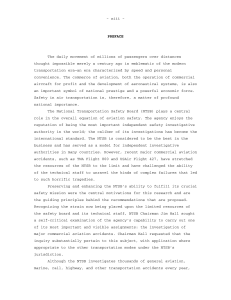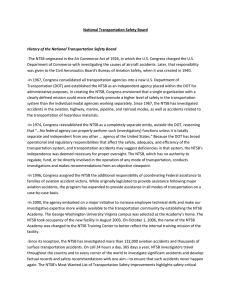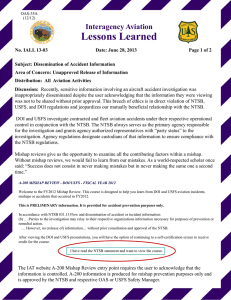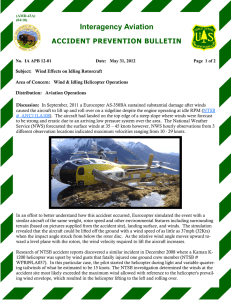- 237 - CHAPTER 7
advertisement
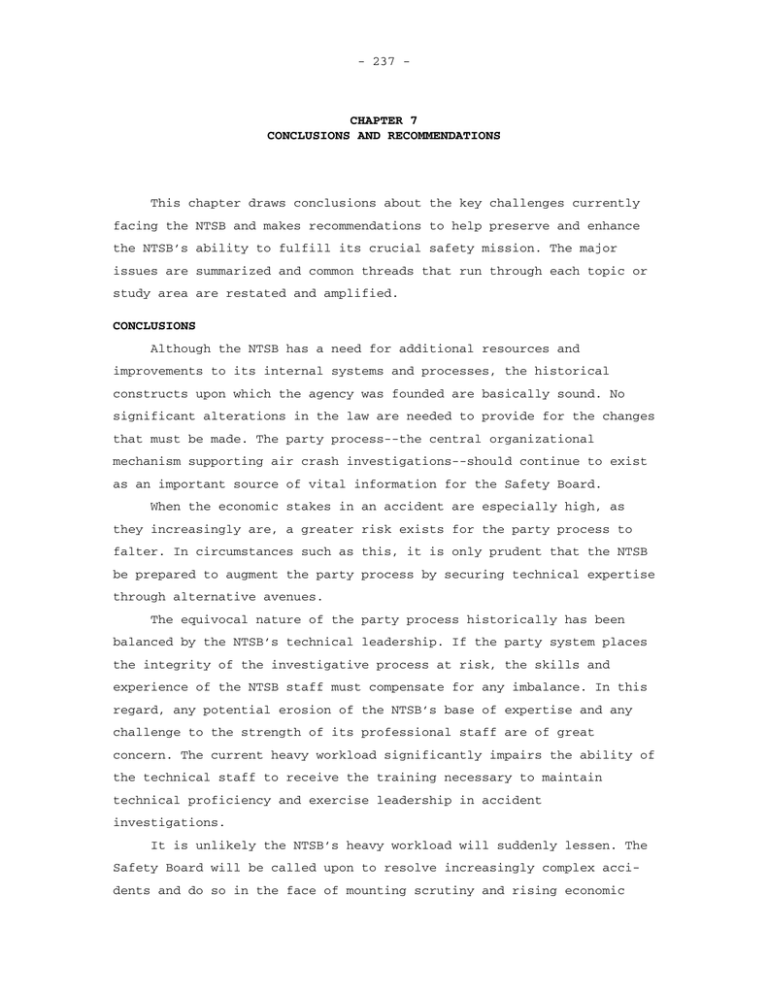
- 237 - CHAPTER 7 CONCLUSIONS AND RECOMMENDATIONS This chapter draws conclusions about the key challenges currently facing the NTSB and makes recommendations to help preserve and enhance the NTSB’s ability to fulfill its crucial safety mission. The major issues are summarized and common threads that run through each topic or study area are restated and amplified. CONCLUSIONS Although the NTSB has a need for additional resources and improvements to its internal systems and processes, the historical constructs upon which the agency was founded are basically sound. No significant alterations in the law are needed to provide for the changes that must be made. The party process--the central organizational mechanism supporting air crash investigations--should continue to exist as an important source of vital information for the Safety Board. When the economic stakes in an accident are especially high, as they increasingly are, a greater risk exists for the party process to falter. In circumstances such as this, it is only prudent that the NTSB be prepared to augment the party process by securing technical expertise through alternative avenues. The equivocal nature of the party process historically has been balanced by the NTSB’s technical leadership. If the party system places the integrity of the investigative process at risk, the skills and experience of the NTSB staff must compensate for any imbalance. In this regard, any potential erosion of the NTSB’s base of expertise and any challenge to the strength of its professional staff are of great concern. The current heavy workload significantly impairs the ability of the technical staff to receive the training necessary to maintain technical proficiency and exercise leadership in accident investigations. It is unlikely the NTSB’s heavy workload will suddenly lessen. The Safety Board will be called upon to resolve increasingly complex accidents and do so in the face of mounting scrutiny and rising economic - 238 - stakes. The NTSB must also adopt a more proactive posture with respect to accident prevention by studying incidents more carefully, both to support its own investigative processes and to advance national aviation safety goals. The NTSB will also become an increasingly visible aviation safety leader around the globe, supporting foreign investigations and playing a strategic role in reducing the risk of aircraft fatalities worldwide. Therefore, although the number of major airline crashes may diminish as the United States pursues an aggressive aviation safety agenda, the NTSB’s workload will at best remain the same and most likely will rise. It is clear that the NTSB needs additional human resources and facilities. The current heavy workload limits the ability of the technical staff to exploit training opportunities that are available to them. An augmented workforce could provide greater flexibility, which in turn would support increased training. Changes in the administration, frequency, and amount of training are also vitally needed. The NTSB’s current engineering laboratory facilities are barely adequate and are not sufficiently up-to-date given the complexity of the systems being analyzed. When in-house resources prove inadequate for a particular investigation, the NTSB has tended to rely on facilities and equipment supplied by parties to an event. This reliance on support from parties increases the risk of conflict of interest and threatens the Safety Board’s independence, especially in high-profile cases in which NTSB leadership is most crucial. Increased resources alone, however, will not ensure a renewed level of responsiveness and excellence at the NTSB. The Safety Board will need to adopt changes to its operation and processes while introducing a modern project-oriented information management system to efficiently and effectively manage its resources. Such changes are a prerequisite for monitoring the progress of other new initiatives. The challenge is clear: The NTSB must substantially revise its practices, more closely manage its resources, and break out of the cultural insularity that is widening the gap between its staff and the rest of the aviation community. The NTSB leadership must make the requisite improvements while continuing to ensure the independent nature - 239 - of its investigations and maintain the authority of its professional staff. As the NTSB embraces the need for change and tackles the many challenges that lie ahead, sufficient resources must be made available to the NTSB to support the needed modernization. RECOMMENDATIONS Uniquely structured as an independent investigative agency not empowered with any regulatory authority of its own, the NTSB relies on the credibility of its findings and recommendations to persuade other governmental agencies, and powerful commercial enterprises, to accept and implement its conclusions. Excellence is demanded, and the recommendations outlined in this chapter emphasize the need for a Safety Board that is a model of technical and managerial leadership. A recurring theme in these recommendations is the NTSB’s “insularity.” The NTSB has become a very isolated agency, a dangerous trend that could increasingly alienate the Safety Board from the aviation community. The NTSB depends on this community for cooperative investigation support and the collaborative efforts needed to ensure the safety of the National Airspace System. NTSB senior management must focus on breaking away from this pattern of insularity. The Safety Board must demonstrate a greater spirit of cooperation with outside entities, without jeopardizing its independent status. The NTSB must be an open and impartial agent pursuing the cause of aviation safety. Another continuing theme of this study is the need for greater efficiency. Under the glare of media coverage and heightened public interest, the NTSB must marshal an array of resources and expertise, and do so from within the confines of a small agency with a tight budget and limited staff. The NTSB must demonstrate that it can operate with the utmost efficiency. With its enormous mission and limited resources, the NTSB simply has no other choice. RAND’s recommendations are divided into eight proposed objectives designed to assist the NTSB in meeting future requirements for accident investigation. Virtually all of the recommendations are within the purview of the NTSB to implement without the need for legislation or new regulations. - 240 - Strengthen the Party Process The NTSB must consider methods for augmenting the current party process model in order to provide access to independent analytical and engineering resources during the investigation of high-profile accidents. The NTSB should not, however, augment the party system by including family representatives, plaintiff experts, insurers, or other individuals or organizations that have no direct involvement in identifying the technical cause of an accident. The following actions will help the NTSB adopt a strategic view of alliance-building: • Perform a nationwide assessment of federal laboratories, universities, and independent corporate resources to identify the tools, facilities, and experts capable of augmenting NTSB resources. Seek formal memoranda of understanding and other forms of strategic alliances with these entities as required. The exercise of alliances to strengthen NTSB technical capabilities should be viewed as a mechanism for augmenting the existing party system, not corrupting it. • Issue a Board order establishing formal guidelines allowing the chairman discretionary authority to form independent review and assessment teams. These guidelines should define a process by which the chairman, with the support of Board members and in consultation with the OAS, can move aggressively to supplement NTSB teams with outside expertise. The Board order should make it clear that the approval of participating parties is not required for the NTSB to assemble investigative teams with alliance representatives or to include alliance experts as part of ongoing party analyses, should this be deemed beneficial to the technical work. The current party pledge reflects an unrealistic view of the factors at work during an investigation. This pledge should be revised to reflect the actual and inevitable involvement of parties in related civil litigation and the widespread use of NTSB materials in the litigation process. In particular, the NTSB should assess available sanctions to enforce party rules and should apply such sanctions consistently and expeditiously when the rules of party participation have been violated. - 241 - Additional information concerning an accident that comes to light following litigation could significantly affect aviation safety. The NTSB should provide a procedural mechanism other than formal reconsideration to allow review of important safety-related findings. The NTSB should interpret existing rules governing petitions for reconsideration to allow submissions from nonparties, including claimants or their attorneys, when new evidence relating to probable cause or safety recommendations has been discovered through civil litigation. Such an interpretation might, for example, allow supplemental material to be appended to the public record. The NTSB should not require formal proceedings for nonparty submissions unless the submissions make it necessary to amend the probable cause finding or issue additional safety recommendations. Create a More Expansive Statement of Causation The statement of causation is the Safety Board’s most controversial output; it is crucial that this statement be as clear and complete as possible. The NTSB should view the probable cause statement not simply as the final investigative word on an accident but in a larger context, as a signpost supporting future aviation safety goals. To accomplish this, the NTSB should move away from simplistic, one-line probable cause statements and instead consistently adopt a comprehensive statement that reflects the reality that a modern aircraft accident is rarely the result of a single error or failure. The probable cause statement should clearly state the principal event or failure that led to the accident. The probable cause statement should then also include all related causal factors. These causal factors should be ranked in terms of their contribution to the event, according to methods to be outlined in Safety Board investigative procedures. Modernize Investigative Procedures The NTSB should take a more proactive stance in examining incidents, both to support far-reaching national goals and also to ensure that its investigators are “up to speed” should a major accident occur. NTSB procedures for prioritizing workload should be modified to include - 242 - a modest expansion in the resources dedicated to identifying and investigating aircraft incidents that have critical safety implications. In parallel, the NTSB should perform more safety studies and report safety trends from incident analyses. Reflecting national priorities and concerns, the NTSB should also formally recognize a legitimate role in the investigation of breaches of security, both in the air and on the ground. The NTSB should undertake a comprehensive independent review of its existing statutory mandate to investigate all general aviation accidents, potentially leading to the legislative revision of this requirement. The growth of general aviation traffic and the proliferation of various types of personal aircraft are likely to increase the NTSB’s workload, both in terms of the number of accidents and the complexity of general aviation investigations. The NTSB should examine whether every general aviation accident raises nationally important safety issues sufficient to merit the expenditure of NTSB resources in conducting an investigation. The NTSB should consider the feasibility of training state and local investigative authorities to conduct more routine general aviation accident investigations, thereby confining the NTSB role to data collection and dissemination, the investigation of complex accidents of national importance, and the conduct of broad-based safety studies in the general aviation field. The NTSB must also adopt strategies that successfully meet the challenge of modern air accident investigation, while reflecting a broadening investigative role. Most important, the NTSB should comprehensively review procedures and contrast them with the increasingly complex world of aviation. Modernizing the methods used to investigate accidents should begin with these steps: • Review the role and responsibilities of the IIC, especially for major aircraft accident investigations. The NTSB should explore the notion of recasting the IIC role into one of a PM in charge of the accident investigation and should provide the tools required to manage the ensuing effort. - 243 - • Examine alternative team structures (such as the notional metateam concept), particularly for the investigation of complexsystem accidents. Compare and contrast the approaches of other failure boards, such as those used by the U.S. Air Force and NASA. This examination should stress the efficacy of multidisciplinary teams to examine complex events. • Evaluate the potential of a senior advisory team concept that may better utilize the NTSB’s senior investigative staff. The use of senior staff members to manage investigations should be limited. Instead, the NTSB’s most senior staff members should be viewed as a shared resource, a source of expert team review, and as mentors to junior investigators to promote the development of midlevel managers. Streamline Internal Operating Procedures Several actions can reduce workload and improve the flow of investigative products. In particular, the current process for producing the Final Accident Report should be less cumbersome and more visible to those who must ultimately approve the product--the Board members. The following recommendations should reduce the time and resources required to complete accident investigations: • Provide the NTSB chairman and Board members with the option of requesting a technical peer review of final accident reports and safety studies prior to review by Board members. This course should be reserved for complex investigations and should have the aim of ensuring the technical excellence of the final product. As a baseline, the peer-review team should consist of at least three technical experts selected at random from NTSB senior investigators. One of the three experts should be a reviewer external to the NTSB with no party affiliation. Peer review comments should be confidential, and the accident investigation team should formally respond to peer-review comments. • Enforce strict time lines for the preparation and release of Final Accident Reports. The NTSB should lengthen its one-year - 244 - baseline for major accidents to a more realistic 18-month baseline, with a 30-month maximum for any investigation. The current Board order describing the overall process for report preparation should be revised to include this time line and to allocate a greater percentage of the time to investigation and analysis than to report writing. One final set of streamlining recommendations relates to the way in which the NTSB manages information. Safety Board investigations involve fact-finding and analysis, and the final product is information. The quality of NTSB products must be very high, and accuracy must be ensured. This assurance depends, to a large extent, on the agency’s ability to acquire, control, and distribute large quantities of information. The following recommendations are designed to improve the NTSB’s internal and external information flows: • Elevate information management to a higher level in the organization by establishing an Office of Information Management. This office would be responsible for the overall management of information and would integrate public inquiries, information technology, and analysis and data functions in the current NTSB structure. The office would integrate Safety Board functions such as notation schedules and the management of dockets and also be responsible for logging all information relevant to investigations that moves into or out of the NTSB. • Improve the quality and management of accident or incident information by assigning one full-time person the task of quality control. This individual would ensure the coordination of accident record, recommendation, and publication databases; maintain a tight linkage between the information-management and project-management functions; and validate the ongoing technical accuracy of NTSB-generated data systems that are being propagated outside of the Safety Board. • Evaluate the potential value of a “knowledge agent” to improve electronic access to worldwide incident databases, monitor and establish relationships with outside sources of expertise, and - 245 - ensure dissemination of NTSB-generated knowledge to the broader aviation community. Better Manage Resources Reducing the NTSB staff’s workload is a prerequisite to improved training and more effective and timely completion of investigations. A key to success in this area is the development of management practices and tools that allow tracking the expenditure of resources. The NTSB must establish the requirements for management systems that achieve this goal. Without such practices, there is little assurance that additional resources provided to the Safety Board will be effectively employed. The NTSB should take the following steps: • Implement a system that permits full-cost accounting of all Safety Board activities. This could be accomplished by modifying the NTSB’s current relationship with the DOT for time and attendance reporting, or, preferably, by establishing an independent NTSB timekeeping function. Individual project numbers should be assigned to each investigation. Specific project numbers should also be assigned to support activities, such as training, with a level of exactness that would ensure a comprehensive view of NTSB operations. Time charges and other expenditures for a given project should be merged and provided to project managers at least biweekly. The NTSB should endeavor to complete the implementation of an integrated cost accounting system within one year. • Enact project management practices at all levels by assigning schedules and budgets to all investigations and safety studies. Project workload should be actively balanced across technical efforts at the level of the Office of Managing Director. Detailed project schedules should also be prepared electronically and made available throughout the NTSB internal computer network in near real time. Maintain a Strategic View of Staffing The NTSB should continuously assess its long-range staffing requirements, taking into account the magnitude and nature of accident - 246 - investigation demands, skill needs implied by the emerging fleet mix, and fluctuations in the labor market. Such a staffing plan should be made a Safety Board priority. Several actions are needed: • Seek an initial increase in the number of OAS technical staff of 12 to 14 percent over fiscal year 1999 levels to reduce excessive workloads, permit more time for training, and support the expansion of incident investigations.1 • Explore the feasibility of sharing work loads through personnel exchange arrangements with other civil, military, and private centers with accident investigation expertise. Intergovernmental Personnel Act assignments are one such exchange approach. • Assess the effects of aging staff on the NTSB’s future skill mix, especially in terms of replenishment of critical expertise. The NTSB should include in its staffing plan methods for using mentoring, training, and hiring to ensure the maintenance of critical skills. • Assess the competitiveness of the NTSB’s compensation structure by comparing it with that of government and industry. Consider broader use of compensation options within the existing pay system, including signing and retention bonuses, national resource specialist positions, senior-level and seniortechnical positions, and senior executive service positions. Streamline Training Practices The NTSB must assign a higher priority to training a staff capable of unquestioned leadership during an investigation. In streamlining existing training programs, the NTSB’s senior staff must create a balanced training program that builds management skills, professional capabilities, and investigative expertise. The following recommendations attempt to broaden the NTSB’s approach to training: ___________ 1Such an increase is designed to reduce the average OAS workweek to the threshold of an extended workweek, while including allowances for increased training and incident investigation, and a credit for the introduction of process efficiencies. The adequacy of such a personnel increase should be monitored and adjusted as appropriate. - 247 - • Create a baseline training plan that establishes standards for each major job title. This plan should first set minimum baseline training requirements for various levels within the NTSB. Technical managers at the NTSB should then build upon this baseline by selecting elective training options tailored to the needs of each employee. Training accomplishments should be maintained in employee records. Costs for training accomplished within the baseline plan should be managed within the NTSB’s overhead structure. Elective training, however, should be paid from training accounts assigned to individual technical managers. An emphasis on training should be engendered by making staff training accomplishments part of each manager’s work performance evaluation. A minimum of two weeks per year of formal elective training should be established, with a three-week minimum goal for lessexperienced staff. • The NTSB should create a full-time training officer position to build and maintain the training plan. The training officer should be responsible for identifying and developing training opportunities and maintaining an agency-wide database of training opportunities from which technical managers can identify elective training to meet the needs of individual staff members. Although emphasis should be placed on creating coursework that exploits both on-site technical capabilities and the senior staff for training and teaching, the training officer should also maintain a complete catalog of relevant outside training opportunities. Training opportunities should be listed on an electronic catalog available as an internal Web page. The training officer should also prepare training budgets and regularly inform the NTSB chairman on the status of the training program. • The NTSB general counsel should clarify the NTSB’s policy regarding gratuities in relation to the acceptance of training opportunities offered by private corporations and other government agencies. The acceptance or denial of training - 248 - opportunities should not rely on ad hoc interpretations set forth by the Office of the General Counsel. Rather, they should be evaluated on their technical merit and cost by following NTSB guidelines and elucidated in a standing board order. The NTSB staff should be encouraged to seek outside sources of training when that training is responsive to emerging aviation trends and complements internal training programs. • Emphasize cross-training whenever possible to build multidisciplinary capabilities. The NTSB should consider staff rotation through NTSB organizations, the use of in-house colloquia to share skills and resources, and the expanded use of invited speakers and site visits to gain insights into alternative methods. The NTSB should emphasize broadly based training, and limit training with very focused outcomes. For example, training resulting in the type rating of pilotinvestigators should be limited to exceptional circumstances. Improve Facilities for Engineering and Training The NTSB should review its internal technical capabilities to support future accident investigations, including the potential for crash reconstruction and the requirements for system testing in support of complex accident investigations. The Safety Board’s long-term requirements for facilities should recognize that facilities can serve a dual function and so include consideration of using them for staff training. To conduct this review, the NTSB should commission an external study that looks at technical and training requirements for the next 15 to 20 years for all transportation modes. This multimodal study should • evaluate projected analytical facility and laboratory requirements based on assessments of future accident trends, including the ability of the NTSB to investigate complex failure events • analyze the cost and efficacy of building and equipping new facilities to meet projected needs, as opposed to procuring services and/or obtaining additional capabilities through - 249 - strategic alliances with other government agencies, the private sector, and academia • include the cost and efficacy of using NTSB technical laboratories and capabilities for training instead of obtaining training from outside sources • specifically highlight the cost and efficacy of an NTSB flightsimulator facility to support investigations and training. The NTSB should also improve its technical ability in the areas of modeling and simulation. The number and fidelity of simulation tools should be expanded, and aircraft models should be available in-house for all transport-category aircraft currently operating in the fleet. The NTSB has become a critical link in the chain that ensures the safety of the traveling public in the United States and throughout the world. That link cannot be allowed to weaken. However, unless purposeful steps are taken to modernize the internal workings of the NTSB, supplement its overloaded workforce, and enhance the resources and facilities available to the investigative staff, the continued vitality of the NTSB cannot be guaranteed. It is in the interest of everyone who travels, by whatever mode, to ensure that the NTSB continues to set the world standard for independent accident investigation.
